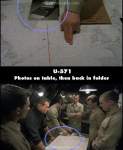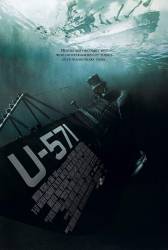Continuity mistake: Just after shooting the radio room on the German destroyer, U-571 submerges so quickly that the sailors do not manage to plug the gun. After a few moments when the boat goes from 180 to 200 meters there is a short shot from the above when we can clearly see that the gun is perfectly plugged. (01:13:30)
Factual error: Although the type of mission depicted in the movie did occur, it was not Americans that were known to do them. Canadian and British teams were specialized to do this mission.
Suggested correction: America did capture a U-boat along with its crew and Enigma equipment... U-505.

Continuity mistake: During the first mission briefing, the commander is pointing to the map and you can clearly see the top secret photos of the enigma sitting by the manila envelope, but right after that shot he pulls the photos out of the envelope and hands them to people. (00:24:20)
Factual error: Depth charges explode at a distance of some 10 meters from the boat without any fatal effect. In reality fatal (i.e. destroying) distance was some 50 meters. (00:06:00)
Suggested correction: The second sentence is in error. Hull-rupture maximum distance is approximately FIVE meters. K-gun DISPERSION range was selectable from the attacking DD or DE: (1) Mk-6 at 50, 75, and 120 yards, (2) Mk-9 at 60, 90, and 150 yards. Citation: http://uboat.net/allies/technical/depth_charges.htm states "The pressure hull of the U-boat was strong enough to withstand anything but a charge exploding 10 or 20 feet from its hull.", and http://www.math.iitb.ac.in/~manishk/msc_project/OR-Notes-Mirror/OR-Notes/mscmga.ms.ic.ac.uk/jeb/or/intro.html states "As mentioned above the standard 250lb depth charge was believed to have a lethal radius of only 5-6 metres."
I have seen German sources which suggest any depth charge going off closer than 100 meters would be instantly deadly. I don't know where those sites you cite get their info from, but descriptions of battles from the era of from a submariner's perspective make it look extremely unlikely that bombs of the stats which you describe would have been an effective weapon at all.
100 metres is 330ft. If depth charges were that effective, the Battle of the Atlantic would have been won in days. Escort ships used to drop ten charges in a pattern to sandwich the sub when they exploded.
Continuity mistake: After the melee with the destroyer above the surface, they attempt to dive and travel under the keel of the destroyer to escape the deck guns. As the camera is going underwater, the destroyer can be seen, but when the camera is below the surface, its keel cannot be seen.
Continuity mistake: When the German destroyer is with U-571, look at the ship. Notice in the first shots there are 2 gun turrets on either side. Yet in the later shots during the final battle there's only one turret. In addition, right before the turrets are shown turning to fire, look at the ship again - they are already aimed at the U-boat. I guess the Germans felt the need to do this two times.
Revealing mistake: When the U-571's crew member starts firing the MG-34 at the survivors in the rowboat, you can see the ammo belt is all blanks.
Factual error: It takes a whole of two minutes from the discovery of the boarding party and the cry "Alarm" till the first Americans even enter the command central of U-571, and another almost 90 seconds till they secure the radio room. German subs were under strict orders to destroy all secret material the instant they had reason to believe a boarding was probable. To that end, all code books were printed in water-soluble inks on water-soluble paper, and even the electrical connections inside the rotors of the enigma machine were seawater-soluble. (Admittedly the latter was more with the idea of enemies salvaging sunk boats in mind, and I have no information on how fast that decay would have happened) All it would have taken is to lift up one of the floor plates and drop the stuff into the bilge below. And yes, since German subs of the era didn't have answering machines, the radio room would be manned around the clock. For that reason, boarding actions of that sort had to be above all lightning-fast. Dramatic as the fight scene is, in reality it would have ensured that the boarding party came away empty-handed. (00:38:30 - 00:41:45)
Factual error: When Tyler asks Tank "what's the status of the torpedo tube?" His hand is on the periscope tube and it spins freely That tube has many seals on it and is stiffer then that.
Continuity mistake: As the submarine is preparing to leave the dock in one of the movie's first scenes, Bill Paxton, the commander is standing on the top part of the sub. A seaman is walking in Bill Paxton's direction and the camera is at a distance. As the camera zooms in the man walking should have been in the frame under Mr. Paxton but he just disappeared. (00:20:20)
Revealing mistake: At the end of the movie, when the aft torpedo blows up the ship, the pieces that fly into the air hit the water and there is no splash. Obviously computer generated.
Continuity mistake: When Tyler is unhandcuffing Tank and Mazzola's body is lying beside him, in the long shot of the scene, it looks like Tank and Mazzola are a few feet away from each other. But in the overhead shot, they're right beside each other. (01:09:20)
Audio problem: When they spot the long range plane circling the U boat Mazzola starts yelling saying, "Do something Rabbit." A quick shot later you notice that he is still talking but his mouth is not moving. (01:06:00)
Other mistake: There is a scene where Eddie, the mess steward, is taunting the German prisoners while writing numbers on their chests. Watch his writing hand as he's working on 11. He makes an awful lot of strokes, including several horizontal ones. You can see from the next guy, 12, that Eddie's ones are just simple vertical lines, so there's no reason for him to have spent so much time writing on 11's chest. Except that it gave him time to say his whole line. (00:45:40)
Factual error: When the American crew storms the U-571 and reaches the aft compartment, where the last Germans are gathered, we can see a row of bunks on each side of the chamber. The VIIC type has no crew acommodation in this place; the last compartment houses just the electric motors and some pumps and auxiliary machinery, as well as the breach of the aft torpedo tube. (00:43:30)
Revealing mistake: The German destroyer is actually an old converted minesweeper.
Character mistake: Near the beginning of the film, when Tyler calls the crew of the S-33 to quarters, look at the guy two back from Mazzola, on the far right. He has his hands clasped behind his back while he's supposed to be at attention. When Tyler says "At ease," he realizes his mistake, drops his hands to his sides where they're supposed to be, then clasps them behind his back again as he stands at ease.
Factual error: The yard set has a red and white stop sign. Stop signs during WWII were yellow with black letters. (00:12:30)
Factual error: Shortly after the crew of the S33 are forced to take to the U571 and destroy the German Supply Submarine Tyler announces that they will try to sail to Greenland or Land's End (England). From their mid-Atlantic position they would, therefore, need to sail east. In the next scene the submarine is seen on the surface sailing from left to right across the screen with the sun on the other side of them. Since from the North Atlantic the sun would always be to the south this must mean they are sailing west, away from Greenland and England and towards the United States. (00:57:05 - 00:59:25)
Continuity mistake: In both scenes when the sub is being depth charged, how come the lights keep coming on even though you see them blowing out?





